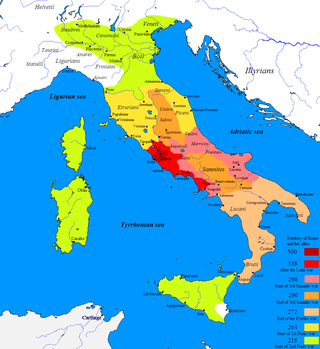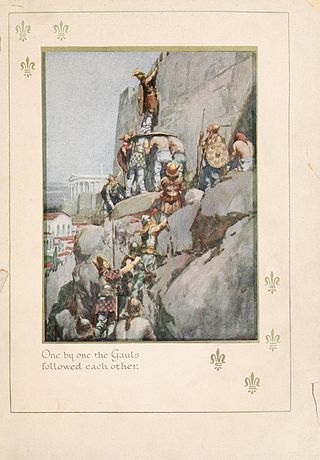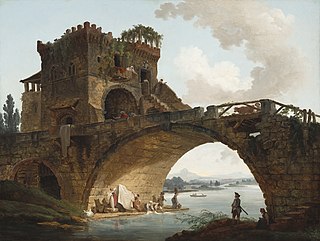Related Research Articles
During the 290s BC, Hellenistic civilization begins its emergence throughout the successor states of the former Argead Macedonian Empire of Alexander the Great, resulting in the diffusion of Greek culture throughout the Levant and advances in science, mathematics, philosophy, etc. Meanwhile, the Roman Republic is embroiled in war against the Samnites, the Mauryan Empire continues to thrive in Ancient India, and the Kingdom of Qin in Ancient China, the one which in the future will conquer its adversaries and unite China, begins to emerge as a significant power during the Warring States period.
Year 340 BC was a year of the pre-Julian Roman calendar. At the time it was known as the Year of the Consulship of Torquatus and Mus. The denomination 340 BC for this year has been used since the early medieval period, when the Anno Domini calendar era became the prevalent method in Europe for naming years.

Year 298 BC was a year of the pre-Julian Roman calendar. At the time it was known as the Year of the Consulship of Barbatus and Centumalus. The denomination 298 BC for this year has been used since the early medieval period, when the Anno Domini calendar era became the prevalent method in Europe for naming years.
Year 296 BC was a year of the pre-Julian Roman calendar. At the time it was known as the Year of the Consulship of Violens and Caecus. The denomination 296 BC for this year has been used since the early medieval period, when the Anno Domini calendar era became the prevalent method in Europe for naming years.
Year 295 BC was a year of the pre-Julian Roman calendar. It was known in the Roman Republic as the Year of the Consulship of Rullianus and Mus. The denomination 295 BC for this year has been used since the early medieval period, when the Anno Domini calendar era became the prevalent method in Europe for naming years.
Year 294 BC was a year of the pre-Julian Roman calendar. At the time it was known as the Year of the Consulship of Megellus and Regulus. The denomination 294 BC for this year has been used since the early medieval period, when the Anno Domini calendar era became the prevalent method in Europe for naming years.
Year 293 BC was a year of the pre-Julian Roman calendar. At the time it was known as the Year of the Consulship of Cursor and Maximus. The denomination 293 BC for this year has been used since the early medieval period, when the Anno Domini calendar era became the prevalent method in Europe for naming years.

Year 290 BC was a year of the pre-Julian Roman calendar. At the time it was known as the Year of the Consulship of Rufinus and Dentatus. The denomination 290 BC for this year has been used since the early medieval period, when the Anno Domini calendar era became the prevalent method in Europe for naming years.

The First, Second, and Third Samnite Wars were fought between the Roman Republic and the Samnites, who lived on a stretch of the Apennine Mountains south of Rome and north of the Lucanian tribe.
Marcus Valerius Corvus, also sometimes known as Corvinus, was a military commander and politician who served in the early-to-middle period of the Roman Republic. During his career he was elected consul six times, beginning at the age of twenty-three. He was appointed dictator twice and led the armies of the Republic in the First Samnite War. He occupied the curule chair twenty-one times throughout his career. According to legend, he lived to the age of one hundred.

Lucius Cornelius Scipio Barbatus was one of the two elected Roman consuls in 298 BC. He led the Roman army to victory against the Etruscans near Volterra. A member of the noble Roman family of Scipiones, he was the father of Lucius Cornelius Scipio and Gnaeus Cornelius Scipio Asina and great-grandfather of Scipio Africanus.
Publius Decius Mus, of the plebeian gens Decia, was a Roman consul in the years 312 BC, 308 BC, 297 BC and 295 BC. He was a member of a family that was renowned for sacrificing themselves on the battlefield for Rome.
Titus Manlius T.f. Torquatus was a patrician Roman Republican consul for 299 BC, elected along with a plebeian co-consul Marcus Fulvius Cn.f. Paetinus.
The Roman–Etruscan Wars, also known as the Etruscan Wars or the Etruscan–Roman Wars, were a series of wars fought between ancient Rome and the Etruscans. Information about many of the wars is limited, particularly those in the early parts of Rome's history, and in large part is known from ancient texts alone. The conquest of Etruria was completed in 265–264 BC.
Gnaeus Manlius Cincinnatus was the first of the patrician gens Manlia to obtain the consulship, which he held in 480 BC, together with Marcus Fabius Vibulanus. His father's name was Publius.

Over the course of nearly four centuries, the Roman Republic fought a series of wars against various Celtic tribes, whom they collectively described as Galli, or Gauls. Among the principal Gallic peoples described as antagonists by Greek and Roman writers were the Senones, Insubres, Boii, and Gaesatae.
Marcus Fabius Vibulanus was consul of the Roman republic in 483 and 480 BC.

The Battle of the Anio River was fought in 361 BC between the Roman Republic, led by the dictator Titus Quinctius Pennus Capitolinus Crispinus, and a group of Gauls who had encamped near the Via Salaria beyond the bridge over the Anio River.
Marcus Valerius Poplicola was a politician of the Roman Republic who served as magister equitum under the dictator Gaius Sulpicius Peticus in 358 and as consul in 355 and 353 BC.
Aulus Cornelius Cossus Arvina was a Roman politician and general who served as both consul and Magister Equitum twice, and Dictator once in the mid 4th century BC.